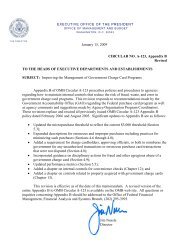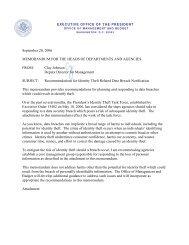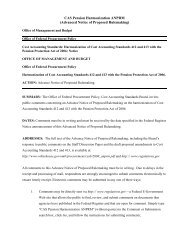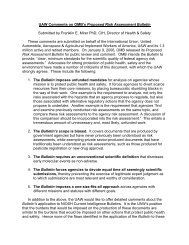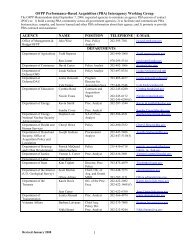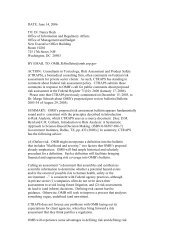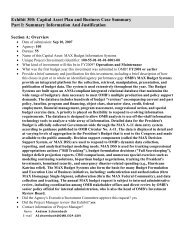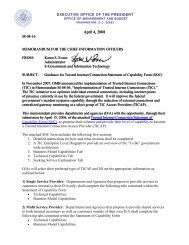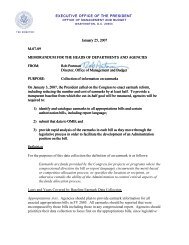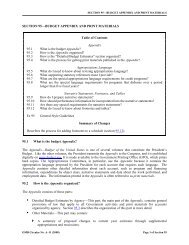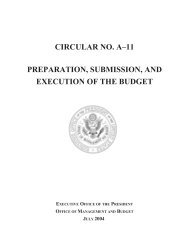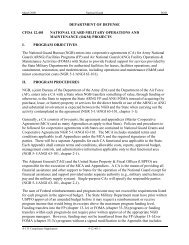The Quiet Revolution (Entire Report in PDF) - the White House
The Quiet Revolution (Entire Report in PDF) - the White House
The Quiet Revolution (Entire Report in PDF) - the White House
You also want an ePaper? Increase the reach of your titles
YUMPU automatically turns print PDFs into web optimized ePapers that Google loves.
C H A P T E R 2<br />
to <strong>the</strong> <strong>in</strong>dividual beneficiary. 15 <strong>The</strong> Court held that “where a government aid program is neutral with<br />
respect to religion, and provides assistance directly to a broad class of beneficiaries who, <strong>in</strong> turn, direct<br />
government aid to religious [organizations] wholly as a result of <strong>the</strong>ir own genu<strong>in</strong>e and <strong>in</strong>dependent<br />
private choice” <strong>the</strong> program is constitutional. 16 In such programs, faith-based organizations are not<br />
required to alter <strong>the</strong>ir religious identity or separate religious activities, as any religious <strong>in</strong>doctr<strong>in</strong>ation<br />
that may take place is <strong>the</strong> result of <strong>the</strong> choice of <strong>the</strong> <strong>in</strong>dividual, ra<strong>the</strong>r than government. 17<br />
Key Modern Establishment Clause Cases<br />
Ø Zelman v. Simmons-Harris, 536 U.S. 639 (2002): <strong>The</strong> U.S. Supreme Court approved a State<br />
program provid<strong>in</strong>g vouchers for children <strong>in</strong> a distressed public school district to attend<br />
private schools, <strong>in</strong>clud<strong>in</strong>g religious schools, as well as neighbor<strong>in</strong>g public schools. <strong>The</strong> Court<br />
held that “where a government aid program is neutral with respect to religion, and provides<br />
assistance directly to a broad class of beneficiaries who, <strong>in</strong> turn, direct government aid to<br />
religious schools wholly as a result of <strong>the</strong>ir own genu<strong>in</strong>e and <strong>in</strong>dependent private choice,” <strong>the</strong><br />
program does not violate <strong>the</strong> Establishment Clause.<br />
Ø Mitchell v. Helms, 530 U.S. 793 (2000): <strong>The</strong> Court upheld a State and locally adm<strong>in</strong>istered<br />
program that loaned educational materials, <strong>in</strong>clud<strong>in</strong>g books, computers, software, and audio/<br />
visual equipment, to schools <strong>in</strong> economically disadvantaged areas, <strong>in</strong>clud<strong>in</strong>g religious schools.<br />
<strong>The</strong> program required schools receiv<strong>in</strong>g <strong>the</strong> aid to limit <strong>the</strong>ir use of <strong>the</strong> materials to “secular,<br />
neutral, and nonideoligical” uses. A majority of <strong>the</strong> Court rejected <strong>the</strong> strict separationist<br />
<strong>the</strong>ory that some organizations are too religious to participate <strong>in</strong> Federal aid programs. <strong>The</strong><br />
plurality described <strong>the</strong> pervasively sectarian dist<strong>in</strong>ction as “offensive,” stat<strong>in</strong>g that, “[i]t is well<br />
established, <strong>in</strong> numerous o<strong>the</strong>r contexts, that courts should refra<strong>in</strong> from troll<strong>in</strong>g through<br />
a person’s or <strong>in</strong>stitution’s religious beliefs,” which “is just what [<strong>the</strong> pervasively sectarian<br />
dist<strong>in</strong>ction] requires.” In her concurrence, Justice O’Connor, jo<strong>in</strong>ed by Justice Breyer, held<br />
that for <strong>the</strong>re to be a constitutional violation <strong>the</strong>re must be actual diversion to religious use;<br />
provid<strong>in</strong>g public aid that merely “has <strong>the</strong> capacity for, or presents <strong>the</strong> possibility of, such<br />
diversion” is not automatically unconstitutional, thus essentially abandon<strong>in</strong>g <strong>the</strong> pervasively<br />
sectarian standard.<br />
Ø Agost<strong>in</strong>i v. Felton, 521 U.S. 203 (1997): In Agost<strong>in</strong>i, <strong>the</strong> Court took <strong>the</strong> rare step of explicitly<br />
overturn<strong>in</strong>g two of its strict separationist decisions. <strong>The</strong> Court upheld a program provid<strong>in</strong>g<br />
remedial education to students of private schools (<strong>in</strong>clud<strong>in</strong>g religious schools), <strong>in</strong> which<br />
<strong>in</strong>struction is given on <strong>the</strong> premises of those schools by public employees. <strong>The</strong> Court<br />
acknowledged that its Establishment Clause jurisprudence had significantly changed<br />
s<strong>in</strong>ce <strong>the</strong> 1970s and 80s, especially with regard to its understand<strong>in</strong>g of what constitutes an<br />
impermissible effect of state <strong>in</strong>doctr<strong>in</strong>ation of religion or constitutes a “symbolic union<br />
between government and religion.” <strong>The</strong> Court did not exam<strong>in</strong>e <strong>the</strong> character of <strong>the</strong><br />
organizations aided by <strong>the</strong> program, and <strong>in</strong>stead focused on whe<strong>the</strong>r any advancement of<br />
religion was reasonably attributable to <strong>the</strong> government.<br />
32 T H E Q U I E T R E V O L U T I O N



